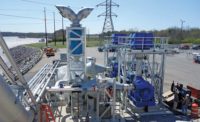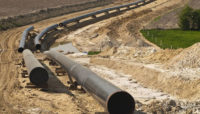Legal
US Court Orders Greenhouse-Gas Emissions Impact in Pipeline Review
Appellate court decision, while split, would color FERC project approvals

Sabal Trail natural gas pipeline under construction in Florida.
Photo: Floridabulldog.org
In a decision that could have broad impact, a federal appellate court said on Aug. 22 that the Federal Energy Regulatory Commission must give an estimate of greenhouse gas emissions that will result from burning natural gas delivered by proposed pipelines to Florida, or explain why it could not have done so.
FERC in February 2016 approved three related pipeline projects under construction in Alabama, Georgia and Florida that will deliver fracked natural gas to utilities. In September it upheld its decision after environmental groups and others challenged it, claiming that the agency’s assessment of the environmental impact of the pipeline was inadequate and failed to adequately consider the project’s contribution to greenhouse gas emissions.
“We agree that FERC’s environmental impact statement (EIS) did not contain enough information on the greenhouse gas emissions that will result from burning the gas the pipeline will carry,” Judge Thomas Griffith said in the 2-1 decision.
But Judge Janice Brown dissented, saying FERC declined to take an in-depth look of downstream greenhouse gas emissions because there is no relationship between approval of the proposed pipeline and the emissions. “The commission here has no authority to prevent the emissions of greenhouse gases through newly constructed or expanded power plants,” Brown said.
The ruling comes just weeks after FERC finally reached its full quorum of commissioners to approval pipeline projects.
FERC is legally authorized to consider downstream environmental effects when evaluating an interstate pipeline application, and at a minimum, it should have estimated the amount of power plant carbon emissions that the pipeline will make possible, Griffith said.
FERC argued that it is impossible to know exactly what quantity of greenhouse gases will be emitted as a result of the project’s approval, but the court noted that FERC has already estimated that the pipelines will deliver 1.1 billion cu ft per day.
The EIS should have either given a quantitative estimate of the emissions or explained why it could not, Griffith said.
The agency's review also needed to include a discussion of the significance of those emissions and the incremental effect of adding them to other past, present and reasonably foreseeable future actions, the court said.
By quantifying the emissions, FERC could consider the total from a state or region or a comparison to regional or national emission control goals. “Without such comparisons, it is difficult to see how FERC could engage in informed decisionmaking with respect to the greenhouse gas effects of this project or how informed public comment could be possible,” Griffith said.
The Sierra Club applauded the decision. “For too long, FERC has abandoned its responsibility to consider the public health and environmental impacts of its actions, including climate change,“ Elly Benson, staff attorney, said.
The three projects are the 515-mile Sabal Trail pipeline in Alabama, Florida and Georgia; the 44-mile expansion of the Hillabee project and the 126-mile Florida Southeast project that will carry natural gas to a Florida Power & Light power plant.
The $3-billion Sabal Trail pipeline began operating this year. A spokeswoman for Sabal Trail Commission, the line's joint venture operator, told Reuters that the firm is reviewing the decision and that it "will not affect operations at this time."




